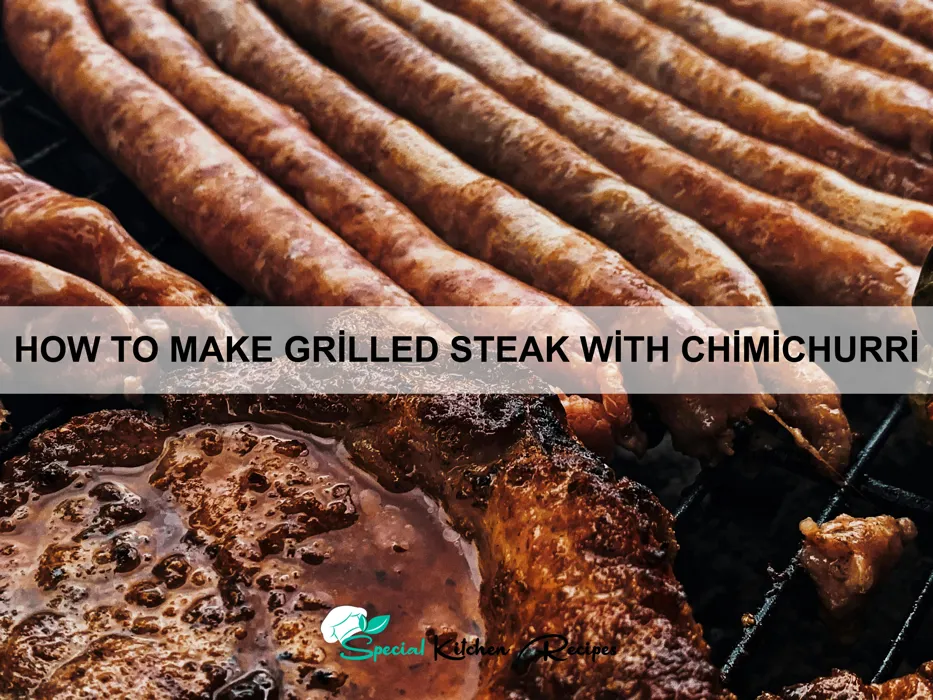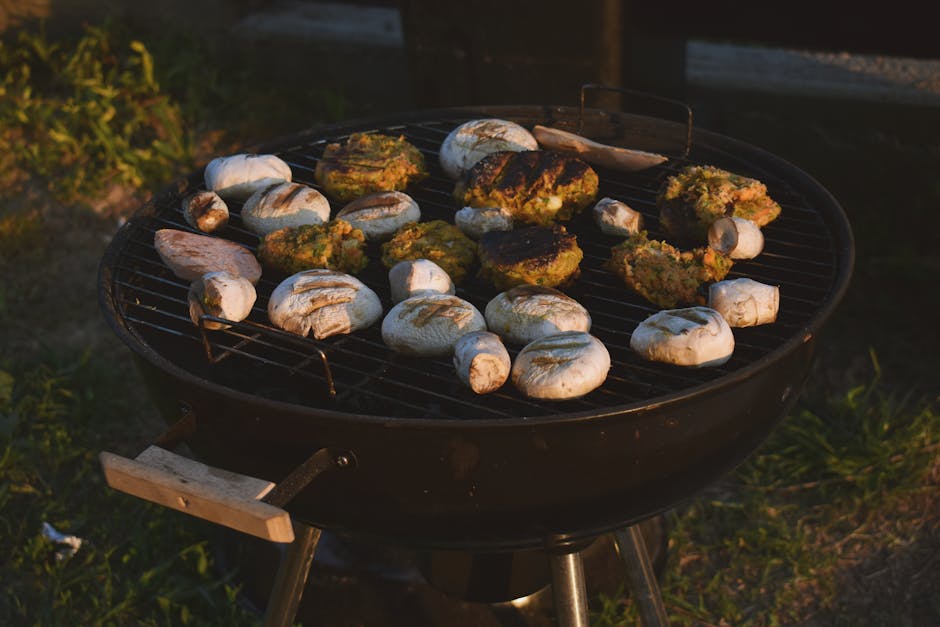Few culinary experiences are as primal and satisfying as a perfectly grilled steak. This recipe explores the art of creating a succulent grilled steak, elevated by the vibrant, herbaceous punch of chimichurri sauce. While the simplicity of grilling a steak might seem straightforward, its history is rich and varied, reflecting the global appreciation for this protein powerhouse. Beef consumption globally is staggering, with estimates exceeding 60 million tons annually, highlighting its importance in diverse cuisines worldwide. The act of grilling itself dates back millennia, with evidence suggesting early humans used fire to cook meat as far back as 1 million years ago. Different cultures have developed their unique grilling techniques and preferences, resulting in a vast array of delicious preparations.
The chimichurri sauce, our chosen accompaniment, boasts its own captivating history, originating in Argentina. Its exact origins are debated, with some attributing it to Basque immigrants in the 19th century, while others point to earlier influences within Argentinean culinary traditions. Regardless of its precise beginnings, chimichurri quickly became a staple in Argentinean cuisine, a vibrant counterpoint to the rich flavor of grilled meats. The sauce’s fresh, bright flavors – derived from parsley, oregano, garlic, olive oil, and red wine vinegar – beautifully cut through the richness of the steak, creating a harmonious balance of textures and tastes. Its popularity has extended far beyond Argentina’s borders, becoming a beloved condiment in many parts of the world, showcasing the global appeal of simple yet powerful flavor combinations.
This recipe aims to bring together the timeless tradition of grilling steak with the vibrant freshness of chimichurri. We’ll guide you through selecting the optimal cut of beef, mastering the grilling technique to achieve that perfect sear and juicy interior, and crafting a truly authentic chimichurri sauce. The combination of these two culinary elements creates a dish that is both satisfyingly simple and incredibly flavorful, representing a delicious fusion of culinary traditions from across the globe. Prepare to embark on a culinary journey that celebrates the age-old art of grilling and the exciting versatility of this iconic Argentinan sauce.
Ingredients and Measurements
This recipe yields two servings of delicious grilled steak with chimichurri sauce. The quality of your ingredients will significantly impact the final flavor, so choose wisely!
For the Steak:
- Two (2) 8-ounce steaks, your choice of cut. Ribeye, New York strip, or sirloin are excellent options. Ensure the steaks are at least 1-inch thick for optimal grilling and tenderness. Thinner cuts will cook too quickly and may become tough.
- 2 tablespoons olive oil. Use a high-quality extra virgin olive oil for the best flavor.
- 1 teaspoon kosher salt. Kosher salt is preferred for its larger crystals, which allow for even seasoning. Adjust to your taste preference.
- 1/2 teaspoon freshly ground black pepper. Freshly ground pepper offers a superior flavor compared to pre-ground.
For the Chimichurri Sauce:
- 1 cup packed fresh parsley leaves. Use flat-leaf parsley for the best flavor and texture. Avoid using curly parsley, as it can be bitter.
- 1/2 cup packed fresh cilantro leaves. Fresh cilantro is crucial for the authentic chimichurri flavor.
- 1/4 cup red wine vinegar. A good quality red wine vinegar adds depth and acidity.
- 1/4 cup olive oil. Use the same olive oil as for the steak for consistency.
- 2 cloves garlic, minced. Freshly minced garlic is best. Use a garlic press or finely chop it.
- 1 teaspoon dried oregano. Use high-quality dried oregano for the best aroma.
- 1/2 teaspoon red pepper flakes (or more, to taste). Adjust the amount of red pepper flakes to your preferred level of spice.
- 1/4 teaspoon salt. Taste and adjust the salt as needed.
Important Note: Bring your steaks to room temperature for at least 30 minutes before grilling. This ensures even cooking. Also, adjust the quantities of ingredients based on the number of servings you are preparing. For example, double the ingredients to make four servings.
Professional Tip: For a richer chimichurri sauce, let it sit for at least 30 minutes after preparation to allow the flavors to meld. This step is highly recommended for the best taste experience.
Preparation of the Steak
Choosing the right steak is crucial for a successful grilled experience. For this recipe, we recommend a 1.5 to 2-inch thick cut of ribeye, New York strip, or filet mignon. These cuts offer excellent marbling and tenderness, resulting in a juicy and flavorful steak. Ensure your steak is at room temperature before grilling. This allows for even cooking and prevents a tough, cold center. Take the steak out of the refrigerator at least 30-45 minutes prior to grilling.
Pat the steak dry with paper towels. This is a vital step often overlooked. Excess moisture on the surface of the steak will prevent a good sear, resulting in a steamed rather than grilled texture. A dry surface is key to achieving those beautiful grill marks and a delicious crust.
Season generously with salt and freshly ground black pepper. Don’t be shy with the salt! About 1 teaspoon of kosher salt per pound of steak is a good starting point. Freshly ground black pepper adds another layer of flavor. You can also add other seasonings such as garlic powder, onion powder, or paprika, but keep it simple to let the natural flavor of the steak shine through. Press the seasoning gently into the steak to ensure it adheres properly.
For an even more flavorful steak, consider a simple marinade. A quick 30-minute marinade of olive oil (2 tablespoons), balsamic vinegar (1 tablespoon), and minced garlic (2 cloves) can add depth and richness. Avoid overly acidic marinades as they can make the steak tough. If using a marinade, ensure you pat the steak dry again before grilling to achieve the best sear.
Optional: For an extra flavorful crust, you can add a thin layer of high-quality olive oil to the steak after seasoning. This will help the seasoning adhere better and contribute to a richer crust. Avoid adding oil to a hot grill as it can cause flare-ups. Instead, lightly oil the grates of the grill.
Once your steak is prepared, you are ready to move on to grilling. Remember, preparation is key to a perfectly grilled steak. By following these steps, you ensure your steak is ready to achieve that perfect sear and juicy interior.
Making the Chimichurri Sauce
The chimichurri sauce is what elevates this grilled steak to a culinary masterpiece. Its vibrant, herbaceous flavor perfectly complements the rich, savory steak. Accuracy in measuring ingredients is key to achieving the ideal balance of flavors.
Begin by gathering your ingredients: 1 cup packed fresh parsley leaves (flat-leaf is preferred), ½ cup packed fresh cilantro leaves, ¼ cup red wine vinegar, ¼ cup extra virgin olive oil, 2 cloves garlic, 1 teaspoon dried oregano, ½ teaspoon red pepper flakes (adjust to your spice preference), and a generous pinch of sea salt. Use high-quality ingredients; the freshness of the herbs will significantly impact the final taste.
Wash and thoroughly dry the parsley and cilantro leaves. This prevents excess water from diluting the sauce and impacting its consistency. Roughly chop the herbs. Don’t worry about making them perfectly uniform; a slightly rustic chop adds to the charm of the chimichurri. Avoid over-processing the herbs, as this can release too much chlorophyll and make the sauce bitter.
In a medium-sized bowl, combine the chopped parsley and cilantro. Mince the garlic cloves finely – a garlic press works well for this. Add the minced garlic, red wine vinegar, oregano, red pepper flakes, and sea salt to the bowl. Taste and adjust seasonings as needed. Some prefer a more pronounced garlic flavor, while others might want to increase the red pepper for extra heat. This is your chance to personalize the recipe.
Slowly whisk in the extra virgin olive oil. Start with a small amount, whisking continuously to emulsify the oil with the herbs and vinegar. Gradually add the remaining oil, whisking constantly to create a smooth, homogenous sauce. The consistency should be similar to a thick vinaigrette.
Once the chimichurri is fully emulsified, taste it again and adjust the seasoning if necessary. You can add more vinegar for acidity, olive oil for richness, or red pepper flakes for heat. Allow the chimichurri to rest for at least 30 minutes at room temperature. This allows the flavors to meld and deepen, resulting in a more complex and flavorful sauce. The chimichurri can be stored in an airtight container in the refrigerator for up to a week.
Serve your delicious chimichurri sauce alongside your perfectly grilled steak! Enjoy!
Grilling the Steak
Once your steak is seasoned (as detailed in the previous section), it’s time to tackle the grilling process. The key to a perfectly grilled steak is achieving a delicious sear while maintaining the desired internal temperature. We’ll be aiming for a beautiful crust and a juicy, tender interior.
Preheat your grill to high heat. This is crucial for creating that iconic sear. Aim for a temperature of around 450-500°F (232-260°C). You should be able to hold your hand about 4-6 inches above the grates for only 2-3 seconds before needing to remove it due to the intense heat. If using a gas grill, preheat all burners to high for at least 10 minutes. For charcoal grills, use enough charcoal to create a bed of hot coals, allowing them to ash over for optimal heat.
Oil the grates: Lightly oil your grill grates to prevent sticking. Use a high-smoke-point oil like canola or grapeseed oil. A clean grill is essential for a good sear. You can use a paper towel secured to tongs to apply the oil evenly across the hot grates.
Sear the steak: Place the steak directly onto the preheated grates. Avoid moving the steak for the first 3-4 minutes to allow a proper sear to develop. This creates the Maillard reaction, responsible for the flavourful crust. After the initial sear, use tongs to carefully flip the steak. Continue grilling, flipping every 2-3 minutes, until the steak reaches your desired internal temperature. Use a meat thermometer to ensure accuracy.
Internal Temperature Guide:
- Rare: 125-130°F (52-54°C)
- Medium-Rare: 130-135°F (54-57°C)
- Medium: 135-140°F (57-60°C)
- Medium-Well: 140-145°F (60-63°C)
- Well-Done: 145°F+ (63°C+)
Rest the steak: Once cooked, immediately remove the steak from the grill and place it on a cutting board or plate. Loosely tent it with foil and let it rest for at least 5-10 minutes. This allows the juices to redistribute throughout the steak, resulting in a more tender and flavorful final product. Do not skip this crucial step!
Thickness Matters: Remember that thicker steaks require longer cooking times. Adjust the grilling time based on the thickness of your steak and your desired doneness. Always use a meat thermometer to check for doneness, rather than relying solely on visual cues.
Resting the Steak
Resting your steak is arguably the most important step after grilling, often overlooked but crucial for achieving the perfect result. This process allows the juices, which have been pushed to the outside during cooking, to redistribute evenly throughout the meat. Skipping this step will result in a dry, tough steak, negating all your hard work on the grill.
How long should you rest your steak? The general rule of thumb is to rest your steak for at least half the total cooking time. For example, if you grilled your steak for 10 minutes, rest it for 5 minutes. For a thicker cut, such as a 1.5-inch thick ribeye, cooked to medium-rare (around 130-135°F internal temperature), you should plan on a resting period of 8-10 minutes. A thinner cut, like a 1-inch sirloin, might only need 5-7 minutes.
Where should you rest your steak? Choose a warm place, away from drafts. A wire rack placed over a baking sheet is ideal, allowing air circulation around the steak and preventing it from steaming in its own juices. Avoid resting it directly on a plate, as this can lead to the steak becoming cold and soggy. You can loosely tent the steak with aluminum foil to retain some heat, but don’t wrap it tightly, as this will trap steam and negate the benefits of resting.
Why is resting important? During cooking, muscle fibers contract, squeezing out juices. Resting allows these fibers to relax, absorbing the juices back into the meat, resulting in a more tender and flavorful steak. This also helps to even out the internal temperature, ensuring a more consistent level of doneness throughout the cut. Ignoring this crucial step leads to a significant loss of moisture and a less enjoyable eating experience.
Using a meat thermometer: While resting, resist the urge to cut into the steak to check for doneness. This will release more juices, leading to a drier steak. Instead, use a meat thermometer before you begin resting to ensure it has reached your desired internal temperature. The temperature will continue to rise slightly during the resting period (carry-over cooking), so aim for a slightly lower temperature than your target before removing it from the grill.
Enjoy the results: Once the resting period is complete, slice your steak against the grain and serve immediately with your delicious chimichurri sauce. You’ll notice a significant difference in both tenderness and juiciness compared to a steak that hasn’t been properly rested.
Plating and Serving
Plating your grilled steak with chimichurri is as important as the cooking process itself. A visually appealing presentation elevates the dining experience and showcases your culinary skills. For a single serving, you’ll need a 10-12 inch dinner plate. Avoid using plates that are too small, as they can make the presentation cramped, or too large, as they’ll make the steak look lost.
Begin by placing a generous spoonful (approximately 2 tablespoons) of the chimichurri sauce in the center of the plate. This creates a vibrant green base that complements the steak’s rich brown color. Don’t spread the chimichurri; leave it in a slightly mounded form for visual interest.
Carefully transfer the grilled steak to the plate, resting it on top of the chimichurri. Ensure the steak is placed strategically – slightly off-center is generally more visually appealing than directly in the middle. Consider the steak’s sear marks; if they’re particularly nice, angle the steak to showcase them.
For added visual appeal and textural contrast, consider adding some simple accompaniments. A small side of roasted asparagus (approximately 4-6 spears) or a simple salad (around 1/2 cup) can be placed alongside the steak. Avoid overcrowding the plate; maintain a balance between the steak, chimichurri, and any side dishes.
If you’ve cooked extra chimichurri, consider adding a small dollop or a decorative drizzle alongside the main portion on the plate. This adds a touch of elegance and ensures there’s ample sauce for the diner to enjoy. A small sprinkle of flaky sea salt on the steak itself just before serving can further enhance the presentation and taste.
Before serving, allow the steak to rest for a few minutes. This allows the juices to redistribute, resulting in a more tender and flavorful cut. Resting time is crucial; it should be at least 5-10 minutes, depending on the thickness of the steak. Serve immediately while the steak is still warm and the chimichurri is vibrant.
Finally, consider the overall aesthetic. Use clean, unblemished plates and avoid any excessive garnishes. Simplicity and elegance are key to successful plating. A well-plated steak with chimichurri is a testament to both culinary skill and attention to detail.
Recommendations
For the best results when making Grilled Steak with Chimichurri, ensure your steak is at room temperature before grilling for even cooking. Pat the steak dry with paper towels to achieve a good sear. Don’t overcrowd the grill; allow space for proper heat circulation. Use a meat thermometer to ensure the steak reaches your desired internal temperature. Rare is 125°F (52°C), medium-rare is 130-135°F (54-57°C), medium is 140-145°F (60-63°C), and well-done is 160°F (71°C) or above.
Serving suggestions are plentiful! This dish pairs beautifully with a variety of sides. Consider serving your grilled steak with a simple salad of mixed greens and cherry tomatoes, dressed with a light vinaigrette. Roasted vegetables like asparagus, bell peppers, or zucchini are also excellent choices. Garlic mashed potatoes or creamy polenta provide a comforting counterpoint to the richness of the steak. For a complete meal, serve with a side of crusty bread to soak up the delicious chimichurri sauce.
Storage is key to maintaining freshness and quality. Allow the steak to cool completely before storing it in an airtight container in the refrigerator. The steak will last for 3-4 days. The chimichurri sauce can also be stored separately in an airtight container in the refrigerator for up to a week. Reheat gently in a skillet or microwave, avoiding overcooking.
Nutritional Information (per serving, approximate): Calorie counts vary drastically depending on the cut and size of steak. A 6-ounce sirloin steak will have approximately 300-400 calories. This is a good source of protein and iron. The chimichurri sauce adds minimal calories but provides vitamins and antioxidants from the herbs. Always check the nutritional information of your specific ingredients for accurate values.
To enhance the overall dining experience, consider offering a selection of beverages to complement the meal. A crisp, dry red wine like a Cabernet Sauvignon or Malbec will pair exceptionally well with the rich flavors of the steak and chimichurri sauce. Alternatively, a refreshing beer or sparkling water will also be enjoyable choices.





